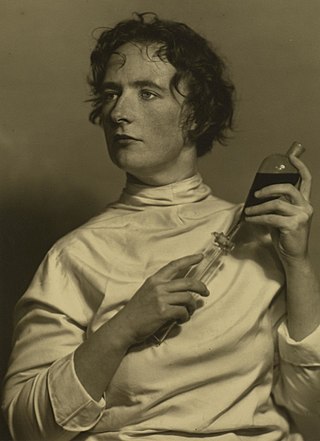Related Research Articles

Faculty of Medicine, Dentistry and Health Sciences is the largest faculty of University of Melbourne, with the most post-graduate students, and also hosts the most school departments and centres of all University of Melbourne Faculties, consisting of 52 faculty sub-organisations. In 2021, Melbourne Medical School was ranked 25th in the world and second in Australia in the 2021 QS Subject Rankings.

Alfred Gottschalk was a German biochemist who was a leading authority in glycoprotein research. During his career he wrote 216 research papers and reviews, and four
Suzanne Cory is an Australian molecular biologist. She has worked on the genetics of the immune system and cancer and has lobbied her country to invest in science. She is married to fellow scientist Jerry Adams, also a WEHI scientist, whom she met while studying for her PhD at the University of Cambridge, England.
Sir Richard Rawdon Stawell KBE, was an Australian medical doctor and the President of the Victorian branch of the British Medical Association.
The Melbourne Dental School is one of the graduate schools of the University of Melbourne. In addition to the 4-year graduate dental program the Doctor of Dental Surgery, the school offers specialty training programs combined with the Doctor of Clinical Dentistry degree, advanced training programs, and research degrees including M.Sc. and Ph.D. programs. According to the QS World Rankings, it is the highest ranking dental school in Australia and often ranks among the top 25 in the world.

Otto Knut Olof Folin was a Swedish-born American chemist who is best known for his groundbreaking work at Harvard University on practical micromethods for the determination of the constituents of protein-free blood filtrates and the discovery of creatine phosphate in muscles.
The Baker Heart and Diabetes Institute, commonly known as the Baker Institute, is an Australian independent medical research institute headquartered in Melbourne, Victoria. Established in 1926, the institute is one of Australia's oldest medical research organisations with a historical focus on cardiovascular disease. In 2008, it became the country's first medical research institute to target diabetes, heart disease, obesity and their complications at the basic, clinical and population health levels.

Dame Kate Isabel Campbell, DBE, FRCOG was a noted Australian physician and paediatrician. Campbell's discovery, that blindness in premature babies was caused by high concentrations of oxygen, resulted in the alteration of the treatment of premature babies world-wide and for this she received global recognition.

Sylvia Agnes Sophia Tait was an English biochemist and endocrinologist. She worked with her second husband, James Francis Tait, from 1948 until her death in 2003, a partnership described by the Oxford Dictionary of National Biography as "one of the most successful examples of husband-wife scientific collaboration". Together, they discovered and identified the hormone aldosterone, the last of a series of naturally occurring biologically potent steroid hormones to be isolated and identified between the 1920s to the 1950s, after the androgens, oestrogens, and glucocorticoid hormones. Aldosterone is part of the mechanism that regulates blood pressure, and causes conservation of sodium, secretion of potassium, increased water retention, and increased blood pressure. It is thought to be responsible for 15 per cent of cases of high blood pressure.

Jane Stocks "Jean" Greig was a Scottish-Australian medical doctor and public health specialist.
Vicki Anderson is an Australian clinical neuropsychologist and researcher. Since 2002 she has been the Theme Director of the Critical Care and Neurosciences group at the Murdoch Children's Research Institute in Melbourne, Australia, and she established the Australian Centre for Child Neuropsychological Studies at the Royal Children's Hospital.
Margaret Sabine (1928–2011) was the pioneering virologist for Australian veterinary schools. She conducted studies on viruses in cats and horses, with her characterisation of different equine viruses being her most significant scientific contribution. Other achievements include becoming head of the department of veterinary pathology and bacteriology, being chairwoman of the NSW Animal Welfare Advisory Council, an honorary Veterinary Science degree at the University of Sydney, and being a co-discoverer of viral interference.

Leslie "Les" Lazarus was an Australian endocrinologist who was one of the first co-Directors of the Garvan Institute of Medical Research, Sydney from 1966 to 1969 and sole Director from 1969 to 1990. At the Garvan Institute he led a joint laboratory and clinical research team studying diabetes and pituitary hormone secretions, in particular the secretion and clinical uses of human growth hormone.

Audrey Josephine Cahn was an Australian microbiologist and nutritionist.
Lucy Meredith Bryce was an Australian haematologist and medical researcher, who worked with the Australian Red Cross Society to establish the first blood transfusion service in Australia.

Svend Peter Klinken is an Australian medical researcher and academic. He is currently the Chief Scientist of Western Australia. He was appointed a Companion of the Order of Australia (AC) in the June 2017 Queen's Birthday Honours.
Judith Ann Whitworth is an Australian medical researcher in the areas of kidney function and blood pressure. Now an emeritus professor, she is the former director of the John Curtin School of Medical Research and Howard Florey Professor of Medical Research at the Australian National University (ANU).
Walter Ramsden was a British biochemist and physiologist. He discovered the phenomenon now known as Pickering stabilization in 1903, before the effect was independently rediscovered by Spencer U. Pickering in 1907.
Charles Nicholas "Nick" Hales was an English physician, biochemist, diabetologist, pathologist, and professor of clinical biochemistry

Marjorie Elizabeth Dulcie Bick was an Australian biochemist.
References
- ↑ "Electric Elevators". The Daily News. 23 August 1905.
- ↑ "Women Graduates Bid Farewell to Their President". Argus. 4 September 1937. Retrieved 4 April 2017.
- ↑ "Biographical Entry". Encyclopaedia of Australian Science. Retrieved 4 April 2017.
- ↑ "Splatt, Beryl Audrey Pickering".